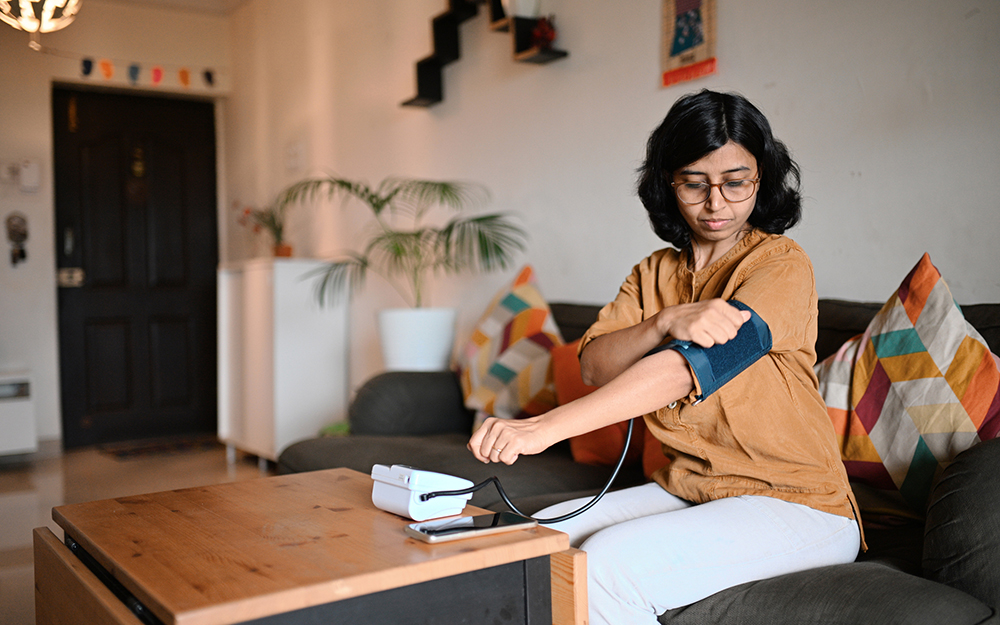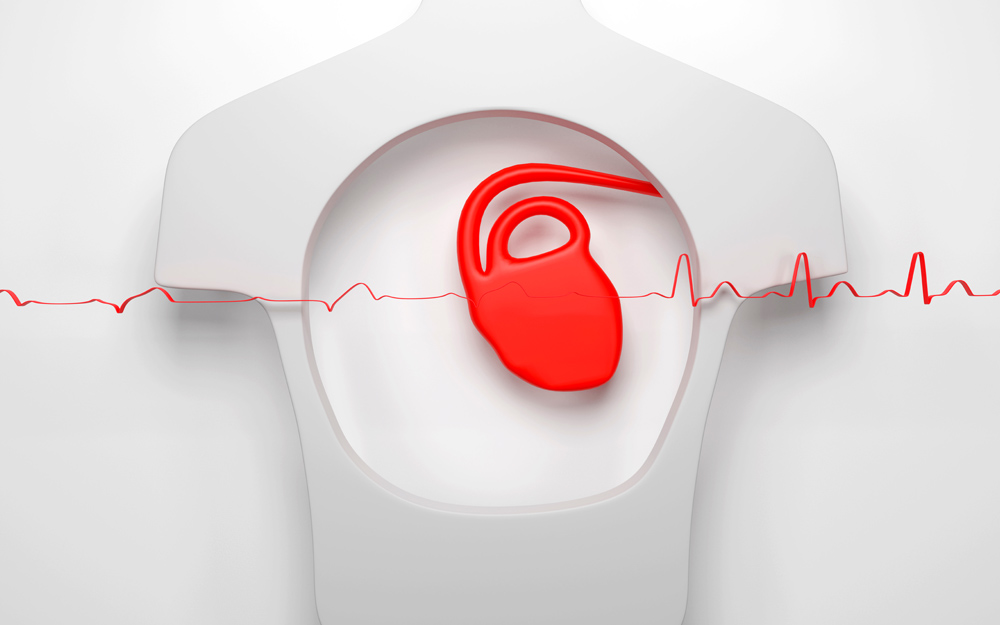New Baby? Pick Up a New Blood Pressure Cuff, Too
Date
February 29, 2024

Date
February 29, 2024
Credits
Medical providers featured in this article


In Brief
{{cta-block}}
When stocking up on the necessities for life with a newborn—diapers, onesies, cute beanies and snuggly blankets—consider adding an important self-care item to your list: a home blood pressure cuff.
Pregnancy and the precious period after a baby is born is an exciting, meaningful and often stressful time. It’s also a time for moms to make their health a priority, especially when it comes to their hearts.
“There is a strong connection between hypertensive disease in pregnancy and preterm delivery with the development of later heart disease—which is the No. 1 killer of women,” said Margo Minissian, PhD, RN, ACNP-BC, executive director of Nursing Innovation and Research and the Simms/Mann Family Foundation Chair in Nursing Education, Research and Innovation, who has spent much of her career studying the link between pregnancy outcomes and women’s heart disease. “We want to empower women to be aware of these associations because the sooner they are aware of their own risk, the more power they have to change their health trajectory.”
Women who experience preeclampsia, eclampsia, gestational hypertension and preterm birth are at an increased risk of developing heart disease, having a heart attack or stroke.
“It’s important for women to take notice if they develop one of these conditions, and recognize this as a warning sign,” said Sarah Kilpatrick, MD, PhD, chair of the Department of Obstetrics and Gynecology. “Then, they can also recognize there are steps they can take to reduce their risk.”
Lifestyle changes such as exercising, maintaining a healthy weight and embracing a heart-healthy diet are long-term measures for reducing and managing risk. Women should also include conditions encountered in pregnancy, such as preeclampsia or preterm birth, when they are giving their health history to their care providers.
“It’s important for the rest of your life,” said Natalie Ann Bello, MD, director of Hypertension Research at Smidt Heart Institute. “Be sure your pregnancy history is in your medical record, because later in your life it will help your doctors when we’re trying to decide, for example, if your cholesterol is at a level where you might need a medication instead of lifestyle changes alone.”
Cedars-Sinai experts offered the following tips for pregnant and postpartum women.
Recognize the Symptoms of Heart Disease
Some of the signs of heart disease are easily dismissed as ailments commonly associated with being pregnant or having a newborn—such as swelling.
“Pay attention to what your body is telling you,” Minissian said. “Don’t be quick to dismiss these symptoms. Bring them up with your doctor. Swelling is a telltale sign that your blood pressure is potentially too high for you—and it might start in your ankles or your hands.”
In short, if your rings or your shoes aren’t fitting, bring it up with your doctor.
Other symptoms to be mindful of during pregnancy or after delivery:
- Headache
- Vision changes
- Chest pain
- High blood pressure—Anything over 130/80 mmHg should prompt a discussion with your doctor
- Shortness of breath
- Difficulty breathing when lying flat
{{providers}}
Check Your Blood Pressure at Home
Women who are discharged from the hospital with prescription medication to manage their blood pressure must check their blood pressure at home at least twice a day, Kilpatrick said.
Furthermore, if you leave with medication in hand, you should have a plan for managing that medication. Plans vary from person to person—some will go back to their OB-GYNs, to a primary care physician or other doctor. Be sure to make your plan before leaving the hospital.
Sometimes, high blood pressure can develop postpartum—even after returning home.
“In most cases, a bad headache shouldn’t ever be chalked up to simply being postpartum,” Kilpatrick said. “You need to think about hypertension.”
Because these symptoms can develop later, it’s wise to have a home blood pressure cuff handy.
“I personally think all postpartum moms should be checking their blood pressure,” said Leah Spiro, NP, DNP, a nurse practitioner and clinical nurse research scientist. “Sometimes it can drop in the first couple of days after delivery, then spike back up around the time you’re going home, when many may feel overwhelmed and frazzled with a new baby.”
It’s also a good idea to be aware of low blood pressure, Kilpatrick said. If you’re on a medication to lower your blood pressure and begin to feel dizzy or lightheaded, perhaps when standing up, that could be a sign your blood pressure is too low. Contact your doctor—and don’t stop a medication without discussing it with your doctor first, Kilpatrick said.
“Pay attention to what your body is telling you. Don’t be quick to dismiss symptoms. Bring them up with your doctor."
Use an Accurate Blood Pressure Cuff
Not all blood pressure cuffs are made equal—even if your device is FDA-cleared. Consult the US Blood Pressure Validated Device Listing, a free resource available at validateBP.org, Bello suggested. The listed devices include affordable budget models as well as fancy ones that link to smartphone apps and more.
If your device isn’t on the website, you can bring it to a doctor’s appointment so they can compare the reading on your blood pressure cuff with in-office equipment, Bello said.
“It’s my No. 1 rule of home blood pressure measurement,” Bello said. “We want to make sure numbers are true and valid before we start making medical decisions based on them.”
Check Your Blood Pressure With Precision
To take accurate blood pressure readings, these are a few things to remember:
- Avoid smoking, exercise and caffeine for 30 minutes before taking your blood pressure.
- Go to the bathroom first.
- Uncover your arm.
- Stay still and relaxed for five minutes before taking the reading—that means no “doomscrolling” on your phone.
- Place your feet flat on the floor.
- Don’t talk.
- Rest your arm on a table or other secure surface so it is supported and at the level of your heart.
When Your Blood Pressure Is High
If your blood pressure is high shortly after delivery, the first step is to call your OB-GYN. Your OB-GYN should have a 24-hour number that is reachable. If you can’t reach your doctor, don’t hesitate to go to the hospital.
For patients who deliver at Cedars-Sinai, they’re advised to return to Labor and Delivery if they’re having serious hypertension symptoms within two weeks of giving birth, Kilpatrick said.
“We know them, and we don’t want any delay in them being accessed and cared for,” she said.
Make a Follow-Up Appointment
Women with high blood pressure during pregnancy or after giving birth should make an appointment with their OB-GYN or primary care provider to discuss their blood pressure.
Ideally, women would be seen by a provider within a week of being discharged from the hospital after delivering, Spiro said.
In fact, it’s always a good time to check in on your heart health, Bello said.
“I’m biased because I’m a cardiologist, but I think everyone should be concerned about their heart health always,” she said. “In addition, we focus on empowering individuals. At the same time, we need to build more support and outreach to help moms and other new parents.”





